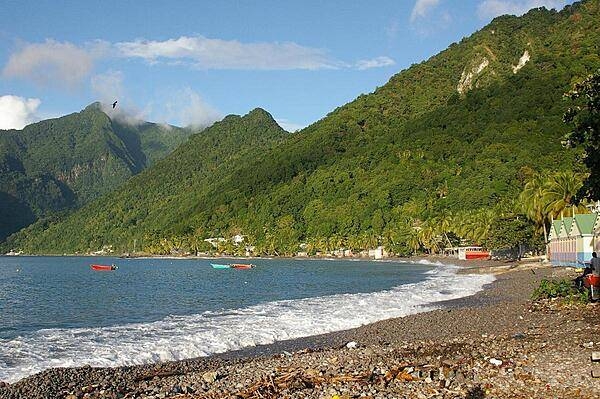15 Dominica

Green with a centered cross of three equal bands – the vertical part is yellow (hoist side), black, and white and the horizontal part is yellow (top), black, and white. Superimposed in the center of the cross is a red disk bearing a Sisserou parrot, unique to Dominica, encircled by 10 green, five-pointed stars edged in yellow. The 10 stars represent the 10 administrative divisions (parishes). Green symbolizes the island’s lush vegetation. The triple-colored cross represents the Christian Trinity. The yellow color denotes sunshine, the main agricultural products (citrus and bananas), and the native Carib Indians. Black is for the rich soil and the African heritage of most citizens. White signifies rivers, waterfalls, and the purity of aspirations. The red disc stands for social justice.
Flag courtesy of the CIA World Factbook


View of the south side of the island. Dominica features lush mountainous rain forests, and is the home of many rare plant, animal, and bird species (including the Sisserou Parrot featured on its flag).
Photo courtesy of the CIA World Factbook
Government
According to Britannica, the constitution adopted at independence provides for a president as head of state and a prime minister as head of government. The legislative branch of government, called Parliament, consists of the president (ex officio) and a single-chamber House of Assembly. Of the 32 total house members, 21 are elected from constituent districts; 9, called senators, are presidential appointees; and 1, the speaker, is elected either from among members who do not belong to the cabinet or from outside the House of Assembly. The attorney general is also considered a member of the house. The president is elected by the legislature, and the prime minister is appointed by the president from among the elected members of the House of Assembly. The prime minister heads a cabinet chosen by the president from among members of the house, although no more than three cabinet members may be senators. Terms of office are for five years, and there is universal adult suffrage. Dominica is a member of the Commonwealth, the United Nations, the Organization of American States, the Caribbean Community, and the Organisation of Eastern Caribbean States (OECS). Dominica uses the Eastern Caribbean dollar (EC$), the common currency of the OECS.
Organization of Eastern Caribbean States (OECS)
The Organization of Eastern Caribbean States (OECS) is an eleven-member grouping of islands spread across the Eastern Caribbean. Together, they form a near-continuous archipelago across the eastern reaches of the Caribbean Sea. They comprise the Leeward Islands: Antigua and Barbuda, Saint Kitts and Nevis, Montserrat, Anguilla, and the British Virgin Islands; and the Windward Islands: Dominica, Saint Lucia, Saint Vincent and the Grenadines and Grenada, Martinique and Guadeloupe.
Eastern Caribbean Civil Aviation Authority (ECCAA)
The Eastern Caribbean Civil Aviation Authority (ECCAA) evolved from the Directorate of Civil Aviation – Eastern Caribbean States, which may be considered as one of the oldest, if not the oldest institutions in the Eastern Caribbean region. From inception, the Directorate was seen as a vehicle for facilitating a collective and uniform approach to Civil Aviation matters affecting the then Windward and Leeward Islands, which now comprise the OECS Group.
Airspace
SkyVector – Google Maps – ADS-B Exchange
ICAO countries publish an Aeronautical Information Publication (AIP). This document is divided into three parts: General (GEN), En Route (ENR) and Aerodromes (AD). ENR 1.4 details the types of airspace classes they chose to adopt from classes A through G.
Drone Regulations
General Regulations – defines unmanned aircraft
Advanced Air Mobility (AAM) Regulations & Policies
None found by the author.
However, should you, the reader, happen to stumble across something to the contrary, please email the author at FISHE5CA@erau.edu and you may be mentioned in the ACKNOWLEDGEMENTS section of this book by way of thanks for contributing to this free eBook!
Advanced Air Mobility (AAM) News
None found by the author.
However, should you, the reader, happen to stumble across something to the contrary, please email the author at FISHE5CA@erau.edu and you may be mentioned in the ACKNOWLEDGEMENTS section of this book by way of thanks for contributing to this free eBook!
Short Essay Questions
Scenario-Based Question
You have been hired by a Drone Startup Company. Your boss has immediately assigned this job to you.
They need you to prepare a one-page memo detailing the legalities of using a drone to locate a rare plant in the rain forest, pictured above.
They need you to mention any national laws and local ordinances.
They specifically want to know what airspace (insert pictures) you will be operating in and whether or not you need an airspace authorization.
Does it matter whether or not you are a citizen of the country?
Lastly, there is a bonus for you if, as you scroll through this chapter, you find any typos or broken links!
Short Essay Questions
- What are the drone categories?
- How is registration addressed?
- How is remote ID addressed?
- What are the model aircraft rules?
- What are the commercial drone rules?
- Are there waivers or exemptions to the rules? If so, for what?
- Would you share a link to an interactive airspace map?
- How is BVLOS addressed?
- How can you fly drones at night?
- How can you fly drones over people?
- Where do you find drone NOTAMs?
- What are the rules for drone maintenance?
- What are the rules for an SMS program?
- What are some unique rules not mentioned above?
- What are the C-UAS rules?
- What are the AAM rules?

